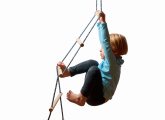Develop fine motor skills and number recognition with these creative water activities from Judith Harries…
Make some coloured ice cubes with the children using drops of food colouring or natural dyes such as orange juice and crushed blackberries. Place them in the water tray and encourage children to handle them. How do their fingers feel? Ask them to observe how long the ice takes to melt. Does it happen quicker on a hot day? Talk about changing states and introduce scientific language such as solids, liquids, frozen, thaw and melt. Alternatively, freeze small toys inside the ice blocks for children to chip at with a variety of tools.
Create an archipelago of islands using floating plastic trays, small world play people, animals and toy boats. Show images of groups of islands online and introduce the word ‘archipelago’ as many young children enjoy the challenge of tackling a new ’long’ word. Encourage the children to play imaginatively, taking people to and from different islands using the boats. Are there any other ways the people could travel? Talk about the different sizes of the islands. Extend play by giving each island a number and transporting that number of people to the island.
Make some recycled bubble shakers to accompany watery songs. If you have different-sized clear plastic bottles with lids, fill each bottle with water, a few drops of food colouring and a small amount of washing up liquid. Add some small beads, bells and buttons. Fasten the lids securely and shake. These will sound and look spectacular as the bubbles are created inside the shaker. Play along to this song, to the tune of ‘The wheels on the bus’: Shake the bubbles, up and down, Up and down, up and down. Shake the bubbles all around, Put the bottles on the ground
Prop up one end of a water tray and attach different sizes of plastic drain piping and tubing. Children will love pouring water in and out of the tray. Let some pipes drain into a paddling pool so the children can paddle and splash on a hot day. You could also add pumps and sieves so children can create their own waterfalls. Extend the activity by using a staple gun or wire to attach different items such as water wheels and funnels to a piece of fencing, trellis or wooden pallet. Hang this above the tray to create waterfalls!
If you have a selection of lightweight plastic bottles or containers, place them in a row on a wall or upturned buckets. Provide children with water pistols and see how many bottles they can knock over using jets of water. Write numbers on the bottles and invite the children to add up the numbers as they knock the bottles over. Sing ‘Ten plastic bottles standing on the wall’ as they play and practise counting backwards. Alternatively, use a roll of aluminium foil to create a slidey pond. Place plastic ducks or boats at one end and invite the children to race the ducks or boats by shooting them along with their water pistols.
Organise some fun water circus activities in your setting. Try a water relay race with two teams of children. Set up two water containers at the end of the course. Ask the children to take turns to run down the track carrying a small jug of coloured water and empty it into their team’s container. The team with the most water at the end wins. And why not try water hoopla with quoits floating in the water tray?
Using halved oranges, lemons and limes, try some fruit printing. Place small amounts of orange, yellow and green paint in shallow trays and let the children print onto black or white sugar paper. After this activity, slice the painted fruit and add sliced oranges, lemons and limes to the water tray. The paint will come off in the water and colour it as the children clean the fruit. Provide sieves, jugs and bowls for the children to use as they play with the citrus fruit. Encourage them to smell the fruit and to describe how it looks, smells and feels.
Judith Harries is an author and teacher of music and drama, with experience of working with children aged nine months to 11 years.

Boost children’s confidence by letting them try
Editors picks

Maths outdoors EYFS – Maths activities to try outside
Editors picks

Going on a Bear Hunt activities – Easy preschool ideas
Editors picks
